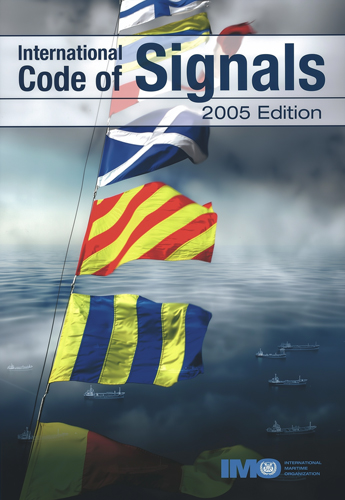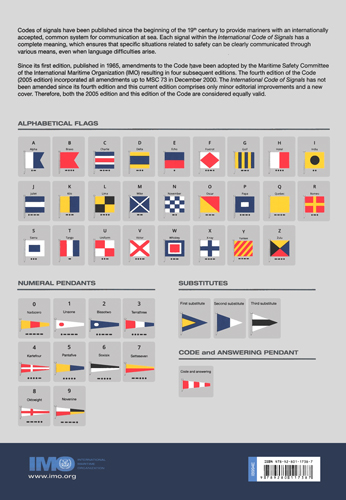International Code of Signals. 2005 Edition
Издание на английском языке
The International Code of Signals (ICS) has a rich history that reflects the evolving needs of maritime communication. Originating in the 19th century, the first International Code was drafted in 1855 by a British Board of Trade committee, containing an extensive array of 70,000 signals and utilizing 18 flags. This code was adopted by many seafaring nations and underwent revisions, notably in 1887, leading to a revised edition in 1897. However, the code faced challenges during World War I, prompting further revisions. The International Radiotelegraph Conference in 1927 initiated a new revision, resulting in a 1930 edition that was adopted in Madrid in 1932. This edition was significant for introducing terminology relevant to aircraft and included a Medical Section, emphasizing its application for both maritime and aviation communication. In the years following, the International Telecommunication Union suggested that the code be managed by the Inter-Governmental Maritime Consultative Organization (IMCO), which later became the International Maritime Organization (IMO). The first Assembly of IMCO in 1959 decided to take over the responsibilities of the previous Standing Committee, leading to a comprehensive review of the code. By 1964, a Sub-Committee had revised the code to address modern maritime needs, focusing on safety and effective communication despite potential language barriers. The revised code was officially adopted in 1965, marking the beginning of a new era for the ICS. Since then, the code has undergone multiple amendments, with the fourth edition published in 2005, incorporating all previous updates. The latest edition features only minor editorial changes, affirming the continued relevance of both the 2005 edition and the current version of the International Code of Signals. This code remains a vital tool for ensuring safe and efficient communication at sea, adapting to the needs of mariners across the globe.
См. также
Оригинальное издание: IMO - International Code of Signals
Отечественное издание: Международный Свод Сигналов (МСС-1965). Адм. № 9016 (+ Корректура. Адм. № 9016К, 1985 г.)
Contents
Preface
Chapter I. Explanations and general remarks
Chapter II. Definitions
Chapter III. Methods of signalling
Chapter IV. General instructions
Chapter V. Flag signalling
Chapter VI. Flashing light signalling
Chapter VII. Sound signalling
Chapter VIII. Radiotelephony
Chapter IX. Morse signalling by hand-flags or arms
Chapter X. Morse symbols - phonetic tables - procedure signals
Chapter XI. Single-letter signals
Chapter XII. Single-letter signals with complements
Chapter XIII. Single-letter signals between ice-breaker and assisted vessels
Chapter XIV Identification of medical transports in armed conflict and permanent identification of rescue craft
General section
I. Distress - emergency
Abandon
Accident - doctor - injured/sick
Aircraft - helicopter
Assistance
Boats - rafts
Disabled - drifting - sinking
Distress
Position
Search and rescue
Survivors
II. Casualties - damages
Collision
Damages - repairs
Diver - underwater operations
Fire - explosion
Grounding - beaching - refloating
Leak
Towing - tugs
III. Aids to navigation - navigation - hydrography
Aids to navigation
Bar
Bearings
Canal - channel - fairway
Course
Dangers to navigation - warnings
Depth - draught
Electronic navigation
Mines - minesweeping
Navigation lights - searchlight
Navigating and steering instructions
Tide
IV. Manoeuvres
Ahead - astern
Alongside
To anchor - anchor(s) - anchorage
Engines - propeller
Landing - boarding
Manoeuvre
Proceed - under way
Speed
Stop-heave to
V. Miscellaneous
Cargo - ballast
Crew - persons on board
Fishery
Pilot
Port - harbour
Miscellaneous
VI. Meteorology - weather
Clouds
Gale - storm - tropical storm
Ice - Icebergs
Ice-breaker
Atmospheric pressure - temperature
Sea - swell
Visibility - fog
Weather - weather forecast
Wind
VII. Routeing of ships
VIII. Communications
Acknowledge - answer
Calling
Cancel
Communicate
Exercise
Reception - transmission
Repeat
IX. International Health Regulations
Pratique messages
Tables of complements
Medical section
Table of Contents
Instructions
I. Request for medical assistance
II. Medical advice
Tables of complements
Medical index
Appendices
Appendix 1 - Distress signals
Appendix 2 - Table of signalling flags
Appendix 3 - Table of life-saving signals
Appendix 4 - Radiotelephone procedures
General index




